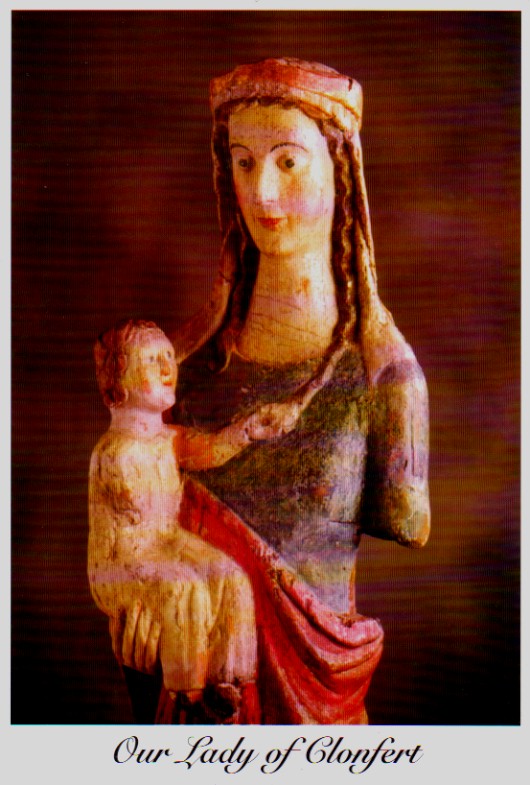Our Lady of Clonfert


The Clonfert Madonna or more commonly known, 'Our Lady of Clonfert', is to be found in the little Catholic church of Clonfert. It is likely to have originated from one of the religious houses attached to the monastic township of Clonfert, either the Cathedral, Abbey or Nunnery. That it was hidden to protect it from being destroyed during one of the religious suppressions is highly probable. The Nunnery was suppressed in the sixteenth century, during which time the destruction of religious images took place, the next century saw Cromwell’s destruction of Church furnishings.
The fact that this Madonna has survived through so many centuries of Religious unrest must surely be evidence of the importance and devotion bestowed upon it from an early age. Of where it was preserved or how it was discovered we are not very sure, but local folk tradition tells us that the Clonfert Madonna was discovered some years ago in the trunk of a tree, by workmen felling timber. We are told that they accidently severed one of the arms of the Madonna, causing it to bleed. Of course, as with all folklore there are variations, a slightly different tale recounted by a local school boy in the 1938-’39 School’s folklore collection reads:
'During the time of religious suppression, someone removed the Madonna for safe keeping from one of the nearby monastic settlements of "Medieval Clonfert", and placed the statue in a tree. It was only in the last [19th] century that a woodcutter, while chopping trees in the area, cut through the trunk containing the statue and blood flowed freely from the trunk. He had severed the Madonna's arm!
'The statue was carefully removed and placed in nearby Meelick Church, on the banks of the river Shannon, however, a local tale has it, that the statue kept turning back in the direction of Clonfert and for that reason, she was returned to where she wished to be . . . Clonfert.'
The statue was taken for restoration to the National Museum in 1945. Miss Cathriona McLeod, the lady responsible for this restoration describes its condition at the time thus:
'The Holy Child is fully draped as was customary in the early 14th century. Unfortunately most of the face and the top of the head have been restored with plaster. The right arm is broken off and the two feet are worn away. The Madonna’s arm has been sawn off. Other parts are decayed and the appearance of the whole figure has been spoiled by recent repainting. On this statue there are at least ten coats of paint. Beneath the surface blue of the robe there are yellow, white, vermillion, brown. pink and lastly yellow upon a gesso base. The flesh tints have also been retouched. Through the modern dull pink on the cheeks appears a hint of rose; and under the dark red of the lips shine specks of bright vermillion. Two black patches blot out the eyes and the broad forehead is now mostly covered with paint to simulate hair.'
Miss McLeod made this further comment on the statue; ‘The Clonfert Madonna is not shown in solemn distant majesty representing a theological doctrine. Here the Mother of God has become also Mother of the Human Race. She has left her remote throne and stands, as it were, within reach of all, like the living Virgin of Nazareth clasping her Child who turns to caress her with his hand.
'The change of sentiment, the tenderness here displayed, reflect that humanism which was introduced into art through the influence of St. Francis. By reconciling nature and religion, by finding in passing things an image of the eternal, by indicating the beauties of nature, of love and of life as manifestations of Divine grace, St. Francis stands as the forerunner of the Renaissance. By contemplating Christ’s humanity men came to know his mother, not as the distant Majesty but as the merciful mother of mankind.'